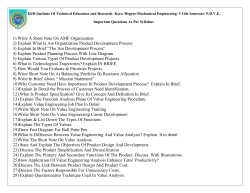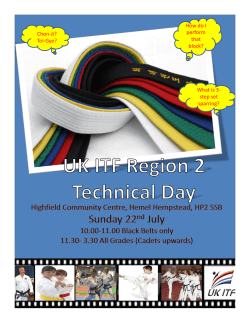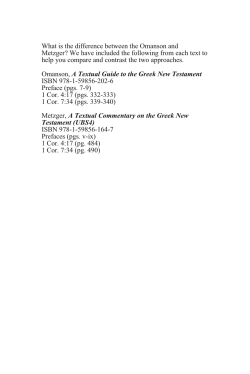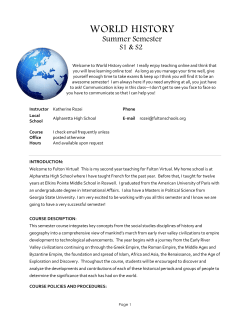
COMMISSION ON HIGHER EDUCATION SAMPLE SYLLABUS TEMPLATE COURSE NUMBER: IT101
COMMISSION ON HIGHER EDUCATION SAMPLE SYLLABUS TEMPLATE COURSE NUMBER: IT101 TITLE: IT Fundamentals DEPARTMENT / PROGRAM: BSIT SCHOOL: SEMESTER AND SCHOOL YEAR: INSTRUCTOR: COURSE DESCRIPTION This course provides an introduction to the industry of Information Technology, an overview of the IT profession, and basic computer concepts. COURSE OBJECTIVES (DESIRABLE OBJECTIVES) At the end of the course, students should be able to: · Operate a personal computer. · Select, use and document appropriate logic design. · Use word processing applications/spreadsheets/presentations · Install OS components and office productivity tools. · Use e-mail and search the web using browsers. · Manage users and resources (files, directories, applications, etc.) through an operating system. · Communicate effectively through written communications and reports. · Know the values and work ethics expected of an ICT professional. · Design algorithms to solve given problems using flowcharting and pseudocoding techniques. COURSE OUTLINE AND TIMEFRAME · TOPICS AND READINGS Basic Computer Concepts o Evolution of Information and Communications IT101 DATE Page 1 · · · · · · · · · Technology o Parts of the Computer o Number Systems Introduction to the Profession o Career Opportunities in ICT o Code of Ethics for ICT Professionals The Components of a Computer System o Hardware o Software o Peopleware Operating Systems o Different OS Implementation (DOS, Linux, UNIX, Windows, Mac, run-time systems) o Human-Machine Interface o Resource Management Latest Trends and Issues in Information Technology ICT Applications in Society Office Productivity Tools * Hardware and Software Installation, Troubleshooting, Maintenance, Upgrading Introduction to Internet Technologies Program Logic Formulation* REQUIRED READINGS SUGGESTED READINGS COURSE REQUIREMENTS CONSULTATION HOURS IT101 Page 2 COMMISSION ON HIGHER EDUCATION SAMPLE SYLLABUS TEMPLATE COURSE NUMBER: IT102 TITLE: Computer Programming 1 DEPARTMENT / PROGRAM: BSIT SCHOOL: SEMESTER AND SCHOOL YEAR: INSTRUCTOR: COURSE DESCRIPTION This course allows the student to learn and apply the art and style of procedural programming to solve computational problems adhering to the standards and guidelines of documentation. It includes discussion on I/O statements, loop and branching instructions, and creating functions and procedures. COURSE OBJECTIVES (DESIRABLE OBJECTIVES) Upon completion of the course, the student should be able to: Apply basic language syntax and basic principles. Apply principles in procedural programming. Determine and apply the debugging techniques for solving errors and inhibiting program acceptance. Adhere to standards and guidelines of documentations. Justify the correctness of the program as well as its documentation as needed. Write a programming project(s) integrating the concepts and principles learned in this course. COURSE OUTLINE AND TIMEFRAME · · TOPICS AND READINGS Problem Solving on the Computer Elements of a Program o Overview Syntax and Semantics o Program Structure IT101 DATE Page 3 · · · · o Directives Basic Data Types Variables and Constants Operators and Expressions Control Structures o Conditional Branching Constructs (If-else, switch) o Looping Constructs (while, while-do, for, repeatuntil) REQUIRED READINGS SUGGESTED READINGS COURSE REQUIREMENTS CONSULTATION HOURS IT101 Page 4 COMMISSION ON HIGHER EDUCATION SAMPLE SYLLABUS TEMPLATE COURSE NUMBER: IT103 TITLE: Computer Programming 2 DEPARTMENT / PROGRAM: BSIT SCHOOL: SEMESTER AND SCHOOL YEAR: INSTRUCTOR: COURSE DESCRIPTION This course allows the student to apply advanced techniques in procedural programming to solve computational problems adhering to the standards and guidelines of documentation. It covers the creation, manipulation and application of user-defined data structures, recursion, and file-handling techniques. COURSE OBJECTIVES (DESIRABLE OBJECTIVES) Upon completion of the course, the student should be able to: Define, construct and use data structure composed of other data types, such as arrays of user-defined data types, in program. Employ functionalities of the language to create, manipulate and destroy arrays of dynamic variables. Regularly follow a modular programming approach in coding. Write a code to create and manipulate two-dimensional arrays. Construct a code to do a simple binary search on an array of sorted data or perform a binary file-handling solution using random access algorithm. Perform review of created code through visual means and/or with the use of debugging tools and correct errors. Practice set procedures for developing maintainable code by adhering to a chosen coding standard. Comply with internal documentation standards and tools. Develop and conduct limited tests to confirm that coding process meets design specifications and practice documentation for tests performed. IT101 Page 5 Rewrite code and documentation to integrate corrections. Write a programming project(s) integrating the concepts and principles learned in this course. COURSE OUTLINE AND TIMEFRAME · · · · · · · · TOPICS AND READINGS Advanced Data Types o Arrays o Records o Lists Strings Sub-programs Procedures and Functions o Language-provided subprograms or Libraries o User-defined subprograms o Scope of Identifiers o Parameters Pointers Structures, Unions, and User-defined Data Types Files Searching and Sorting Algorithms DATE REQUIRED READINGS SUGGESTED READINGS COURSE REQUIREMENTS CONSULTATION HOURS IT101 Page 6 COMMISSION ON HIGHER EDUCATION SAMPLE SYLLABUS TEMPLATE COURSE NUMBER: IT105 TITLE: Computer Organization DEPARTMENT / PROGRAM: BSIT SCHOOL: SEMESTER AND SCHOOL YEAR: INSTRUCTOR: COURSE DESCRIPTION The course presents the various hardware structures (down to transistor level) that compose a computer, their individual functions, how they interact with each other, how they can be organized and controlled to perform the task assigned to the computer. How data is represented, stored and manipulated is also covered. COURSE OBJECTIVES (DESIRABLE OBJECTIVES) Upon completion of this course, the student should be able to: · Gain an understanding of the hardware structures that make computers possible. · Know the different devices and components of a computer system (down to the transistor level), know how these components interact and work together. · Understand computer organization concepts and how they apply to systems development. COURSE OUTLINE AND TIMEFRAME · · TOPICS AND READINGS What is Computer Organization? Components of Computer System o Processor o Memory IT101 DATE Page 7 · · · · · · · o I/O Computer and Data Representation o Number Systems o Fixed-Point and Floating-Point Numbers Logic Design Subsystems Microprocessors and Assembly Language Programming o Addressing Modes o Instruction Sets Processor o General Microprocessor Organization o Single bus architecture § Registers § Buses, gating and Control Sequences § Microprogram Control o Control Unit o Arithmetic Logic Unit § Adders (Half, Full, Fast, CLA) § Subtractor § Multiplication Algorithm (Booth/Extended Booth) § Division Algorithm (Restoring/Nonrestoring) Memory o Types of Memory o Memory caching o Virtual memory o Memory interleaving I/O Organization o Disk Organization o Input-Output Peripherals Basic Interfacing REQUIRED READINGS SUGGESTED READINGS COURSE REQUIREMENTS CONSULTATION HOURS IT101 Page 8 COMMISSION ON HIGHER EDUCATION SAMPLE SYLLABUS TEMPLATE COURSE NUMBER: IT106 TITLE: PROFESSIONAL ETHICS DEPARTMENT / PROGRAM: BSIT SCHOOL: SEMESTER AND SCHOOL YEAR: INSTRUCTOR: COURSE DESCRIPTION The course introduces ethics and ethical theories; provides discussions on the ethical dilemmas and issues facing IT practitioners. An appreciation and discussion of the Code of Ethics of I. T. Professionals; cybercrimes and appropriate Philippine Laws are also included. COURSE OBJECTIVES (DESIRABLE OBJECTIVES) At the end of the term, the students should be able to: · Understand and appreciate the meaning of ethics, values and attitudes. · Be guided in their ethical thinking and considerations as they relate in the cyberworld. · Be aware of the different ethical dilemma/issues in the cybeworld. · Appreciate and internalize the code of conduct of an I. T. Professional. · Be familiar with the various Philippine Laws that penalizes cybercrimes. COURSE OUTLINE AND TIMEFRAME 1. Ethics, values and attitudes. 2. The most common ethical theories. Ancient Greek – Plato Medieval – Thomas Aquinas Immanuel Kant Rawl Theory Justice Egoism Utilitarianism 3. Ethical Dilemma/ issues in the cyberworld Privacy Invasion IT101 Page 9 Hacking Security Theft Copyright Infringement Unfair Competition Virus Tele/videoconferencing Online defamation Piracy Fraud 4. Ethics and Law 5. Applicable Philippine Laws that penalize cybercrime Intellectual Property Right E-Commerce Law Optical Law Civil Code Revised Penal Code Special Criminal Law Unfair Competition Act Internet Pornography 2. Government Agencies Responsible in the Implementation of the Philippine I. T. Programs Commission on Information and Communication Technology National Bureau of Investigation Department of Justice 1. REQUIRED READINGS SUGGESTED READINGS COURSE REQUIREMENTS CONSULTATION HOURS IT101 Page 10 COMMISSION ON HIGHER EDUCATION SAMPLE SYLLABUS TEMPLATE COURSE NUMBER: IT 201 TITLE: ACCOUNTING PRINCIPLES DEPARTMENT / PROGRAM: INFORMATION TECHNOLOGY SCHOOL: SEMESTER AND SCHOOL YEAR: INSTRUCTOR: COURSE DESCRIPTION This course is an introduction to the fields of managerial and financial accounting, focusing more on the latter. It is designed to equip Information Management students with knowledge and skills on accounting processes, systems, concepts, principles, and applications in both a manual and computer-based environment. COURSE OBJECTIVES (DESIRABLE OBJECTIVES) Upon completion of this course, the student should be able to: 1. Define and explain comprehensively key accounting concepts such as financial accounting, cost accounting, and the different financial statement items; 2. Correctly execute the accounting cycle manually, from transaction analysis to report preparation and closing entries; 3. Gather managerial accounting data, prepare managerial reports in good form, and formulate sound decisions based on these; COURSE OUTLINE AND TIMEFRAME 1. 2. TOPICS AND READINGS Accounting: Information for Decision Making Basic Financial Statements a. b. c. d. 3. 4. e. f. g. Definition of a Business Objectives of a Business Forms of Business Organizations Introduction to Financial Statements · A Starting Point: Statement of Financial Position · Income Statement · Statement of Cash Flows Relationships Among Financial Statements The Use of Financial Statements by Outsiders Effects of Business Transactions on the Accounting Equation a. b. c. d. e. f. g. h. i. j. The Accounting Cycle The Ledger The Use of Accounts Debit and Credit Entries Recording Transactions in Ledger Accounts The Journal The Trial Balance What is Net Income? Recording Revenue and Expense Transactions Adjusting Entries a. b. Adjusting Entries Adjusting Entries and Accounting Principles DATE The Accounting Cycle: Capturing Economic Events The Accounting Cycle: Accruals and Deferrals IT101 Page 11 5. 6. 7. 8. 9. The Accounting Cycle: Reporting Financial Results a. b. c. d. e. The Worksheet Preparing Financial Statements Relationship among the Financial Statements Closing the Temporary Equity Accounts After-Closing Trial Balance a. b. c. Merchandising Companies Perpetual Inventory Systems Periodic Inventory Systems a. b. Management Accounting: Basic Framework Accounting for Manufacturing Operations a. b. Cost-Volume Relationships Cost Behavior and Operating Income Accounting for Merchandising Activities Management Accounting: A Business Partner Cost-Volume-Profit Analysis Sample Accounting Packages REQUIRED READINGS SUGGESTED READINGS COURSE REQUIREMENTS CONSULTATION HOURS IT101 Page 12 COMMISSION ON HIGHER EDUCATION SAMPLE SYLLABUS TEMPLATE COURSE NUMBER: IT202 TITLE: Operating Systems Applications DEPARTMENT / PROGRAM: BSIT SCHOOL: SEMESTER AND SCHOOL YEAR: INSTRUCTOR: COURSE DESCRIPTION This course provides an introduction to the concepts, theories and components that serve as the bases for the design of classical and modern operating systems. Topics include process and memory management, process synchronization and deadlocks. COURSE OBJECTIVES (DESIRABLE OBJECTIVES) At the end of this course, the student should be able to: 1. Describe relationships between system services and application software 2. Compare and contrast different design considerations for major OS components COURSE OUTLINE AND TIMEFRAME TOPICS AND READINGS o Overview of Operating Systems · History · Functionality of a typical OS · OS structures DATE o Process Management · Process concept · Process scheduling IT101 Page 13 o Memory Management · MVT, Paging, Segmentation o Virtual Memory · Demand Paging 5. File Management 6. Deadlocks · Prevention · Avoidance · Detection and Recovery 7. Concurrent Processes · Synchronization · Classical Problems (Producer-Consumer, ReadersWriters, Dining Philosophers) · REQUIRED READINGS · SUGGESTED READINGS · COURSE REQUIREMENTS · CONSULTATION HOURS IT101 Page 14 COMMISSION ON HIGHER EDUCATION SAMPLE SYLLABUS TEMPLATE COURSE NUMBER: IT204 TITLE: Systems Analysis and Design DEPARTMENT / PROGRAM: BSIT SCHOOL: SEMESTER AND SCHOOL YEAR: INSTRUCTOR: COURSE DESCRIPTION This course covers the different phases of systems development focusing on analysis and design. Students will learn the rudiments of systems development through a feasibility study. COURSE OBJECTIVES (DESIRABLE OBJECTIVES) Upon completion of this course, the student should be able to: · Perform needs analysis. · Translate business requirements into systems models. · Design solutions for business requirements. · Make a proposal to a variety of business organization and to understand the importance of their system. · Apply interviewing and data gathering techniques and best practices. · Present the result of systems analysis and be able to learn how to compare the existing system to the proposed system. · Design a proposed system and present its feasibility. · Demonstrate the team and interpersonal skills. COURSE OUTLINE AND TIMEFRAME · · · TOPICS AND READINGS Introduction o The Nature of System § System Definition § Classification of System § General System Principle § Players in the System Game Business Processes System Analysis o Overview of Analysis IT101 DATE Page 15 · · · § Analysis Definition § Characteristics of Analysis o Problems of Analysis o Systems Analysis Definition o Advantages and Limitation o Responsibilities of a System Analyst Tools of the System Analyst o System Development Life Cycle o Structured System Analysis o System Model o Tools of Structure Analysis § Modeling System Functions § Modeling Stored Data § Modeling Program Structures § Other Modeling Tools Feasibility Study o Technical Feasibility o Operational Feasibility o Economic Feasibility § Cost Benefit Analysis Systems Analysis Design Approaches o Project Fundamentals § Project Scheduling Tools § Managing Analysis and Design Activities § Fact Gathering Techniques o The Analysis Process § Using Data Flow Diagrams § Using Data Dictionaries § Process Specifications and Structured Decisions § Preparing, Writing and Presenting a System Proposal o The Essentials of Design § Output Design § Input Design § Databases § User Interfaces § Data-Entry Procedures REQUIRED READINGS SUGGESTED READINGS COURSE REQUIREMENTS CONSULTATION HOURS IT101 Page 16 COMMISSION ON HIGHER EDUCATION SAMPLE SYLLABUS TEMPLATE COURSE NUMBER: IT205 TITLE: Software Engineering DEPARTMENT / PROGRAM: BSIT SCHOOL: SEMESTER AND SCHOOL YEAR: INSTRUCTOR: COURSE DESCRIPTION This course introduces the software engineering processes; its principles, techniques and practices to produce quality software products. COURSE OBJECTIVES (DESIRABLE OBJECTIVES) Upon completion of this course, the student should be able to: · Design, develop, deploy, manage and maintain various information systems. · Demonstrate team and interpersonal skills. · Use system development tools in software projects. · Demonstrate written and oral communication skills. · Demonstrate quality consciousness. · Appreciate the value of standards and certification COURSE OUTLINE AND TIMEFRAME TOPICS AND READINGS · · DATE Overview o Phases in Software Engineering o Standards and Certifications o Software Process Models o Project Initiation Requirements Analysis o Software Estimation o Project Estimation IT101 Page 17 · · · · · · · o Project Teams o UML/Use CASES o Activity Diagrams Requirements Design o Design Notation: Modeling Languages o Architectural Models o Screen Design and Usability o Design Patterns o Documentation o Risk Management Systems Development and Coding Systems Testing and Debugging Systems Deployment, Maintenance and Support Configuration Management Capability Maturity Model/Capability Maturity ModelIntegrated Software Evaluation and Validation REQUIRED READINGS SUGGESTED READINGS COURSE REQUIREMENTS CONSULTATION HOURS IT101 Page 18 COMMISSION ON HIGHER EDUCATION SAMPLE SYLLABUS TEMPLATE COURSE NUMBER: IT206 TITLE: Technopreneurship DEPARTMENT / PROGRAM: BSIT SCHOOL: SEMESTER AND SCHOOL YEAR: INSTRUCTOR: COURSE DESCRIPTION This course covers the principles and theories of technoprenuership. Students are expected to develop and implement a feasible IT business plan. COURSE OBJECTIVES (DESIRABLE OBJECTIVES) Upon completion of this course, the student should be able to: Understand the difference between entrepreneurship and technopreneurship Apply the principles and theories of entrepreneurship and management in IT business Understand the interplay between various factors affecting the IT business Develop and implement an IT business plan COURSE OUTLINE AND TIMEFRAME · · · · · · TOPICS AND READINGS Relationship between entrepreneurship, job creation, and the national economy Nature of Entrepreneurship Differences between entrepreneur and technopreneur What is high-tech industry? Idea generation and evaluation IPR, patents and legal issues IT101 DATE Page 19 · · · · · · · · · Financing sources Developing a business plan Starting a business Entrepreneurial finance and accounting Business strategies Marketing, sales, and customer relations Stakeholders management o Investors o Competition o Regulatory agencies o Employees o Financiers o Community (society) Management of the business Global opportunities for entrepreneurs REQUIRED READINGS SUGGESTED READINGS COURSE REQUIREMENTS CONSULTATION HOURS IT101 Page 20 COMMISSION ON HIGHER EDUCATION SAMPLE SYLLABUS TEMPLATE COURSE NUMBER: IT211 TITLE: Object Oriented Programming DEPARTMENT / PROGRAM: BSIT SCHOOL: SEMESTER AND SCHOOL YEAR: INSTRUCTOR: COURSE DESCRIPTION This course allows the student to learn and apply the basic language syntax and principles of object-oriented programming to solve computational problems adhering to the standards and guidelines of documentation. COURSE OBJECTIVES (DESIRABLE OBJECTIVES) Upon completion of this course, the student should be able to: Apply basic language syntax and principles in OO programming language. Determine the debugging techniques for solving errors and inhibiting program acceptance. Adhere to standards and guidelines of documentations. Justify the correctness of the program as well as its documentation as needed. Write a programming project(s) integrating the concepts and principles learned in this course. COURSE OUTLINE AND TIMEFRAME · · TOPICS AND READINGS Introduction to Object-Oriented Programming Concepts Programming Fundamentals o Parts of an OOP Program IT101 DATE Page 21 · · · · · · · · · · · · · · o Syntax and Semantics o Coding Conventions o Data Types o Basic Input/Output o Control Structures Strings Single method programming Static methods Recursions Abstract Data Types o Stacks o Queues Linked Structures Multiple Classes Data Abstraction Inheritance Subclasses Abstract Classes Interfaces Polymorphism File Handling REQUIRED READINGS SUGGESTED READINGS COURSE REQUIREMENTS CONSULTATION HOURS IT101 Page 22 COMMISSION ON HIGHER EDUCATION SAMPLE SYLLABUS TEMPLATE COURSE NUMBER: IT212 TITLE: Database Management System 1 DEPARTMENT / PROGRAM: BSIT SCHOOL: SEMESTER AND SCHOOL YEAR: INSTRUCTOR: COURSE DESCRIPTION The course covers discussion of database systems, the nature of the data, data association, data semantics and data models. A specific DBMS will be used to implement data models for use in business application programs. COURSE OBJECTIVES (DESIRABLE OBJECTIVES) Upon completion of this course, the student should be able to: · Design database using data models. · Use database programming languages to manipulate or process data efficiently. · Perform basic DB administrator’s function. · Understand various implementations of database management systems. COURSE OUTLINE AND TIMEFRAME · · TOPICS AND READINGS Database Development Process Entity Relationship Model IT101 DATE Page 23 · · · · · · · Logical Design Normalization Physical Design SQL Data Administration Introduction to Data Warehousing and Data Mining Data Security REQUIRED READINGS SUGGESTED READINGS COURSE REQUIREMENTS CONSULTATION HOURS IT101 Page 24 COMMISSION ON HIGHER EDUCATION SAMPLE SYLLABUS TEMPLATE COURSE NUMBER: IT214 TITLE: Web Development DEPARTMENT / PROGRAM: BSIT SCHOOL: SEMESTER AND SCHOOL YEAR: INSTRUCTOR: COURSE DESCRIPTION This course covers various web design concepts and techniques that will allow students to design, build and create effective, interactive and dynamic web applications. COURSE OBJECTIVES (DESIRABLE OBJECTIVES) Upon completion of this course, the student should be able to: · Build a GUI applying best practices. · Design and build web applications. · Use client-server technologies. · Understand web services and service-oriented architectures. · Understand and possibly apply virtual team working and best practices. COURSE OUTLINE AND TIMEFRAME · · TOPICS AND READINGS Internet and the World Wide Web Web Technologies o Web Site and Web Portals o Search Engines IT101 DATE Page 25 · · · · · · · o Security o Video and Audio Streaming Principles of Web Design HTML Protocol The Format of a Web Page Support Tools for Web Creation Creating Static and Dynamic Pages Using Web Development Applications Mobile Interfaces Web Site Administration REQUIRED READINGS SUGGESTED READINGS COURSE REQUIREMENTS CONSULTATION HOURS IT101 Page 26 COMMISSION ON HIGHER EDUCATION SAMPLE SYLLABUS TEMPLATE COURSE NUMBER: IT215 TITLE: Multimedia Systems DEPARTMENT / PROGRAM: BSIT SCHOOL: SEMESTER AND SCHOOL YEAR: INSTRUCTOR: COURSE DESCRIPTION This three (3) units course equips the IT student with the skills to develop interactive multimedia applications which combine audio, video, text, animation, and still images that can be delivered from CD-ROM to LAN, from Internet to the Intranet. COURSE OBJECTIVES (DESIRABLE OBJECTIVES) Upon completion of this course, the student should be able to: · Build applications using authoring tools. · Develop creative expressions using digital technology. · Evaluate theoretical aesthetics, perceptual possibilities and technical information with state-of-the art equipment. · Create and support multimedia productions. COURSE OUTLINE AND TIMEFRAME · · TOPICS AND READINGS Multimedia Principles and Concepts Multimedia Hardware IT101 DATE Page 27 · · · · · · Multimedia Software Multimedia Project Management Storyboarding Authoring Tools Editing Tools (Adobe Photoshop, etc.) Interactive Applications REQUIRED READINGS SUGGESTED READINGS COURSE REQUIREMENTS CONSULTATION HOURS IT101 Page 28
© Copyright 2025













